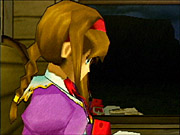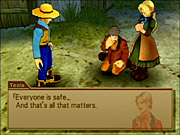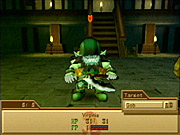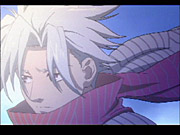You could probably imagine a world with too many Western-themed games for its own good. But that's not a world we live in at the moment. Games about gunslingers trying to stay alive in the Wild West just aren't common, and stuff like six-shooters and cowboy hats isn't nearly as popular in gaming as stuff like swords and helmets. This is understandable, seeing as odds are good that your dad is much more likely to be a fan of Clint Eastwood movies than you are. Nonetheless, there's definitely room for a good Western game every now and then, and Wild Arms 3, the latest in what's now a long-running series of role-playing games, definitely fits that bill. Actually, superficial Western touches aside, Wild Arms 3 is a pretty conventional Japanese RPG that's similar to its predecessor as well as to other games in the genre. And because of its great looks, gameplay twists, and good cast of characters, Wild Arms 3 should appeal to most anyone who likes games of this type.

The first Wild Arms game was released for the PlayStation in 1998 and put a different spin on a style of gaming that had recently been redefined by the epic Final Fantasy VII. First of all, there was no traditional sci-fi or swords-and-sorcery setting to be found in the game, but rather a hybrid Western fantasy world filled with monsters and mystical firearms--the title of the game in fact refers to these weapons. Also, though it basically played like other role-playing games of its time, Wild Arms included a number of action adventure elements to keep the gameplay interesting whenever you weren't engaged in battle. Wild Arms 3 carries on all these traditions, but with a new set of playable characters, a new world to explore, and some much improved production values since the last installment. It's worth noting that 2000's Wild Arms 2 was considered something of a disappointment for being too similar to its predecessor for its own good. The same criticism could be leveled at Wild Arms 3, though it's been long enough since the previous game that this sequel's prospective audience probably won't see this sequel as a rehash.

You control a party of four different characters throughout most of Wild Arms 3. These include a determined girl named Virginia, who sports a couple of high-powered six shooters; a well-mannered, well-intentioned sniper named Clive; a good-natured but somewhat thickheaded Native American-looking man named Gallows, who uses a sawed-off shotgun in battle; and your prototypical too-cool-for-you anime loner, named Jet, who's armed with a machine gun. Though these four by no means break the mold in terms of character design, and though the circumstances in which they decide to forge an alliance are pretty iffy, the heroes of Wild Arms 3 end up being likable. Over the course of the game's story, they'll often learn from each other and help each other out, and each character has his or her own unique abilities and well-defined personality traits. So collectively, they're a good gang.
Wild Arms 3 follows the RPG formula without much variation. There are lots of random battles to be fought, a number of towns to be visited, a number of dungeons to be explored, a number of secrets and hidden treasures to be found, and a number of powerful villains to be vanquished. Besides the fact that much of the game takes place in dusty, windswept regions reminiscent of the Old West, the twists in the game's combat and exploration sequences certainly help distinguish Wild Arms 3 from other RPGs out there. For one thing, though you'll often stumble into random battles, Wild Arms 3 gives you a chance to avoid some of them by timing a button press just before a fight begins. You can skip only so many random battles before your ability to do so is used up (until you rest at an inn), but it's still nice to be able to bail out of the occasional fight before it even starts. Still, this once-innovative feature now seems like a strange way of addressing the problem shared by many RPG players that, well, random battles in RPGs are getting to be pretty old.
Part of the reason you'll want to make good use of the evade-encounter feature is that the combat in Wild Arms 3, while decent, isn't that great. It's pretty simple--you can order your group to attack, guard, use magic (or "arcana" as they call it), or use items. The order in which characters act is based on their initiative, but everyone gets to act during a given turn. As your characters hit their foes, and get hit by their foes, they'll accrue FP (force points) that can then be used to initiate a few special moves or arcana. Your FP levels always start low in each fight, so it's only later on in a battle--if it even lasts that long--that you can unleash some of your most powerful attacks. You may be curious to know how guns figure into the combat in Wild Arms 3, and one way of looking at it is, they sort of don't--at least not in any meaningful tactical fashion. Replace the graphics and sounds of the guns with graphics and sounds of swords, and the combat in Wild Arms 3 could still be exactly the same. Characters do randomly move about the battlefield during their turns, and the distance between the attacker and the target does make a bit of difference, but not much. Simply put, Wild Arms 3's gun battles are more or less the same sorts of slugfests seen in most other RPG combat systems.

Exploration in Wild Arms 3 is a bit different from the norm. The out-in-the-open travel sequences, which fans of the series should be familiar with, aren't quite the straightforward point-A-to-point-B affairs of other RPGs. But that's not to say they're better. The catch is, you need to "search" the area for any locations of note. So, for example, you might get tipped off that there's an ancient dungeon to the east, and then you'll just head on eastward, sending sonarlike search pulses every few steps while trying to avoid random encounters. The weird thing is, the movement speed on the overworld map is extremely fast, lending these sequences an awkward stop-and-go feel that you'll quickly grow weary of. Things fare better inside dungeons (and other interior locations), where there's often a satisfying sense of questing to be had. Your different characters can each use different tools to help get them past different obstacles or to solve puzzles, and these challenges require just enough hand-eye coordination and thinking to serve effectively as a change of pace from all the fighting.
Of course, the story unfolds in between all this, and it's told in a typical fashion mostly using in-engine 3D cutscenes and lots of text. The dialogue is translated well from the original Japanese, and the main characters' respective personalities do tend to come across quite clearly. And while the story goes through many of the usual paces, Wild Arms 3 is a lengthy game that does a solid job of keeping you interested both in the four protagonists and also in a number of their adversaries. The game's generally upbeat tone and occasional use of good-natured humor serve to keep things lively.
Wild Arms 3 has an inspired look to it, something that really benefits an RPG, since these are the sorts of games that you might find yourself sitting in front of for hours on end--they might as well look good. The graphics aren't exactly cel-shaded. As with many of the cartoony games released recently, you'll notice a thick black border around all of Wild Arms 3's fully 3D characters. Yet the textures on the characters aren't flat, but rather have an interesting-looking impressionist blotchiness to them that, if nothing else, looks unusual. This, along with their clearly visible facial expressions, smooth animations, and fully articulated hands, gives the Wild Arms 3 characters a lot of personality. There's considerable detail and decent variety in the game's environments, as well. Each area of an environment tends to be pretty small, but the fully rotatable 3D isometric perspective still affords you with plenty to look at.

A fittingly Western-sounding soundtrack, complete with lots of twanging and whistling, serves Wild Arms 3 well. Some of the tracks do get a bit repetitive, but others effectively serve as themes for different types of situations. The rest of the game's sound effects aren't too noteworthy, though hearing the game's various firearms go off might be a real relief from the sorts of sounds you may be used to from all the combat in other recent RPGs. In any event, perhaps even more so than the graphics, the audio in Wild Arms 3 does a nice job of setting a different sort of tone for the game, one that those who play a lot of RPGs are likely to appreciate.
Actually, those who play a lot of RPGs are likely to appreciate Wild Arms 3 on most counts. It's a well-made game that defies a few aesthetic conventions but leaves most tried-and-true Japanese RPG gameplay elements well enough alone. And since there's a lot of it to keep you busy for a while, Wild Arms 3 is recommended to role-playing fans in general, and particularly to those intrigued by the theme of this game.